Mille Bornes
Mille Bornes (/ˌmɪl ˈbɔːrn/; French for a thousand milestones, referring to the distance markers on many French roads) is a French designer card game. Mille Bornes is listed in the GAMES Magazine Hall of Fame.
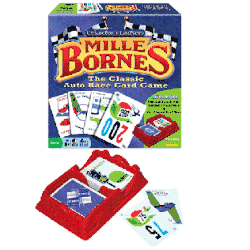 Modern edition | |
| Manufacturer(s) | Winning Moves |
|---|---|
| Designer(s) | Edmond Dujardin, born in Ecuador and raised in France |
| Illustrator(s) | Joseph Le Callennec |
| Publication date | 1954 |
| Genre(s) | Take That |
| Language(s) | English / French |
| Skill(s) required | Medium |
| Media type | Cards |
History
The game was created in 1954 by Edmond Dujardin,[1] and is almost identical to the earlier American automotive card game Touring. One additional feature is the coup-fourré ("counter-thrust"), whereby bonus points are earned by holding back a safety card (such as the puncture-proof tire) until an opponent plays the corresponding hazard card (in this case, the flat tire).[2]
There have been 26 known publishers of the game.[3] Some Mille Bornes decks are printed in both English and French. The Spanish version Mil Hitos, distributed by Heraclio Fournier, was very popular in Spain during the 1970s. In the Netherlands there is a variant of this game, Stap op, which deals with cycling instead of driving. The hazards and distances are different, but the mechanics of the game are exactly the same.
The current U.S. version, published by Asmodee, has purged all French language from the printed cards. The rules still include the "Coup Fourré" however there is no background given to the "counter thrust" translation.[4]
Objective
The premise of Mille Bornes is that the players are in a road race. Each race—or hand—is 1000 miles (or kilometers) long. For two- or three-player games the goal is shortened to 700, with an option for the first player to complete that distance to declare an extension to 1000 miles. Mille Bornes is played with a special deck of cards. There are hazard, remedy, safety, and distance cards. Each hazard is corrected by a corresponding remedy, and can be prevented from happening in the first place by a corresponding safety. The target distance is reached by playing distance cards.
List of cards
- Hazards:
- Accident: 3
- Out of Gas: 3
- Flat Tire: 3
- Stop: 5
- Speed Limit: 4
- Remedies:
- Repairs: 6
- Gasoline: 6
- Spare Tire: 6
- Go/Roll/Drive: 14
- End of Speed Limit: 6
- Safeties:
- Driving Ace: 1
- Fuel Tank: 1
- Puncture Proof: 1
- Right of Way/Emergency Vehicle: 1
- Distance:
- 25 Mile: 10
- 50 Mile: 10
- 75 Mile: 10
- 100 Mile: 12
- 200 Mile: 4
Also included in the deck are nonplayable cards that list the playable cards and summarize the scoring. In some decks, some of these are printed entirely in French.
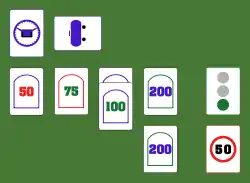
Play
The deck is shuffled and six cards are dealt to each player; the remainder becomes a draw pile and a discard pile forms next to it. Each player's turn begins with a draw of one card and a play of one card, so that each player always holds six cards at the end of his turn.
Each player (or team) builds a tableau. The tableau is divided into battle, speed, distance, and safety areas; cards in the battle and speed areas are stacked so that only the top card shows. The example shows a typical tableau midway through a game.
Hazards and remedies (with the exception of Speed Limit and End of Limit) are played in the battle area, where a Roll card is shown in the example. Speed Limit and End of Limit cards are played separately in the speed area. Distance cards are played into separate stacks according to value; it is common to play the 200-mile cards distinctly, rather than fanned. Safety cards are played along the top of the tableau; note that the horizontal placement of the Extra Tank card in the example has a special significance.
A player may use a card in one of the following ways on his turn:
- A Roll card in his own battle area if it is empty or showing any remedy other than Roll.
- A distance card in his own distance area if a Roll card is showing in his battle area.
- A remedy on top of the corresponding hazard if one is showing in his battle area.
- An End of Limit on top of a Speed Limit if one is showing in his speed area.
- An Accident, Out of Gas, Flat Tire, or Stop hazard in his opponent's battle area if it is not empty.
- A Speed Limit hazard in his opponent's speed area if it is empty or showing an End of Limit. This is the only hazard that can be played against an opponent whose battle area is empty.
- A safety in his own safety area (at any time).
Once an Accident, Out of Gas, or Flat Tire hazard has been played, and the appropriate remedy card played to correct it, the player must next play a Roll card in order to get moving again. A hazard can be played onto an opponent's battle area even if another one is already showing, but only the topmost hazard needs to be corrected before that player can use a Roll card. Playing a Roll against a Stop hazard corrects it and allows the player to start moving; a second Roll is not needed.
Playing a safety corrects the corresponding hazard, if it is in effect against the player at the time, and also prevents opponents from using hazards of this type against the player for the remainder of the hand. However, when the safety is played normally, a Roll must still be played before any distance cards if the corresponding hazard is in effect. Whenever the safety is played, the same player draws another card immediately and plays again. It is possible to play consecutive safeties on one turn, each time drawing a card before playing again.
A player affected by a Speed Limit (as shown in the example) may only play 25 and 50 km cards. No more than two 200 km cards may be played by any player or team in a single hand.
Whenever a hazard is played, any player holding the corresponding safety may immediately play it and declare a coup-fourré. This may be done whether or not the player holding the safety was the one attacked by the hazard. The safety is laid down horizontally in the safety area, and the player draws a new card and takes his/her normal turn (draw and play/discard), skipping all players between the attacker and him/herself. In addition, if he/she was attacked with the hazard, it is moved to the discard pile.
The Right of Way card both remedies and protects against Stop and Speed Limit hazards. If a player uses this safety, he/she need not play a Roll card in order to get moving again; any Stop or Speed Limit cards showing in the battle/speed areas are moved to the discard pile. The player is still vulnerable to any hazard for which he/she has not yet played a safety; however, after remedying it, he/she can begin to play distance cards again without using a Roll card first.
If an uncorrected hazard is revealed in the battle area due to the Right of Way or a coup-fourré being played, and the corresponding safety is not in effect, the hazard must be corrected (and a Roll played, if necessary) in order to start moving again.
Players may always discard, even if they have a legal play available. A player who has no playable cards must discard. All discards are considered dead and may not be used or touched for the remainder of the hand.
Play continues until either:
- one player (or team) has played enough distance cards to exactly reach the target total, or
- all players have played or discarded all their cards.
Under no circumstances may a player or team play a distance card that causes them to exceed the target total.
Note that play continues after the draw pile is exhausted, each player playing or discarding one card per turn. Once every player runs out of cards in their hand with a depleted draw pile, play ends.
The target distance is 1000 km in a four-handed game with two partnerships, or 700 km in a two- or three-player game with each player acting individually. In the latter case, the first player to reach 700 km may either claim victory and end the hand immediately, or call for an Extension that increases the target to 1000 km.
Scoring
Scores are tallied at the end of the hand as follows:
Scored by each side Distance 1 per km traveled Each safety 100 however played All 4 safeties 300 bonus in addition to the standard 100 points for each of the safeties individually plus any coup-fourré bonuses. Coup-fourré 300 bonus in addition to the 100 for playing that safety Scored only by side that completes trip Trip completed 400 for being the winner Delayed action 300 for completing the trip after the draw pile is exhausted Safe trip 300 for completing the trip without playing any 200 km cards Extension 200 for completing the trip after calling for an Extension Shutout 500 for completing a trip before the opponent has played any Distance cards
In a 2-player game, the maximum score that can be made in one hand is 4,600 points. In a standard 4-player game there is no extension, so the maximum score is 4,400. In a 3-player or 6-player game, two shutout bonuses are achievable, yielding a perfect score of 5,100.
Note that some points are scored even if a side does not complete a trip; it is possible for the completing side to score fewer points than their opponents. If the hand ends by exhaustion rather than by completion, each side still scores its distance and safety points.
According to the printed rules distributed by Parker Brothers, a game continues until one or both sides reaches a cumulative point total of 5,000. If both sides go over 5,000 during the same hand, the higher point total wins the game.[5] Note that it is possible for the game to end in a tie, in which case the rules are silent.
If the game is played for money, then generally the point difference is paid from the loser to the winner, and every point is significant.
With larger or smaller groups
2, 3, 4 or 6 Player play is possible with slight rule modifications and where in the case of the 4 or 6 player versions, players team up into teams of two each. For detailed play see Wikibooks article.
Card images
- Hazard cards
 Accident
Accident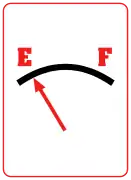 Out of gas
Out of gas Flat tire
Flat tire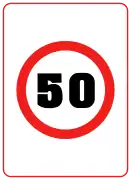 Speed limit
Speed limit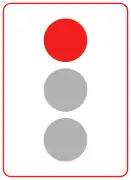 Stop
Stop
- Remedy cards
 Repairs
Repairs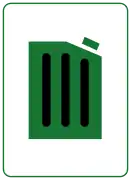 Gasoline
Gasoline Spare tire
Spare tire End of limit
End of limit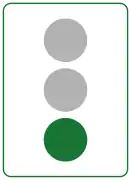 Roll
Roll
- Safety cards
 Driving ace
Driving ace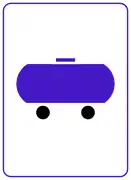 Extra tank
Extra tank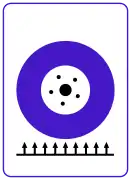 Puncture proof
Puncture proof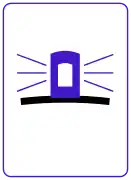 Right-of-way
Right-of-way
- Distance cards
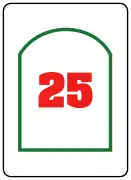 25 km
25 km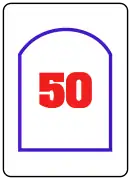 50km
50km 75 km
75 km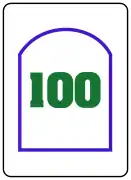 100 km
100 km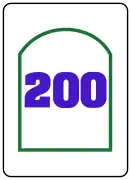 200 km
200 km
See also
References
- Carlisle, Rodney P. (2009). Encyclopedia of Play in Today's Society. Sage Publications. p. xxxviii. ISBN 978-1-4129-6670-2.
- Roche, William Janson (17 May 2011). "History of "take that!" style dedicated-deck card games". A Spotlight on Games. Retrieved 2017-05-08.
- "Mille Bornes". Board Game Geek. BoardGameGeek, LLC. Retrieved 17 December 2019.
- "MIlle Bournes Rules" (PDF). Asmodee USA. Asmodee. Retrieved 17 December 2019.
- citation needed
External links
| Wikibooks has more on the topic of: Mille Bornes |
- Mille Bournes at SourceFiles.org game description, rules, and strategy notes (archived)
- Milestone on irc.globalgamers.net, Milestone on Internet Relay Chat.
- Mille Bornes at ExpressShare.com Freeware Mille Bornes for Windows by Bill Sanders
- Notes and pictures of the distinctive deck artwork by Joseph Le Callennec and other versions